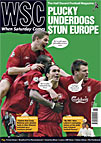 Thanks to the bitter legacy of English rule it has always been impossible to play association football in Ireland’s finest stadium, Croke Park – until now, as Robbie Meredith reports
Thanks to the bitter legacy of English rule it has always been impossible to play association football in Ireland’s finest stadium, Croke Park – until now, as Robbie Meredith reports
Describing football grounds as shrines or cathedrals is fairly commonplace; a lazy marketing trick exploiting a supporter’s passion for their team. One stadium in Dublin, however, explodes the cliche.
Croke Park is the headquarters of the Gaelic Athletic Association, one of the most powerful organisations in Ireland. To many Irish people, Roy Keane is not a footballer, but a soccer player. Instead, “football” denotes Gaelic football, in which the ball is carried as well as kicked and where points are scored by shooting over as well as under the bar.
Croke Park also happens to be, by some distance, the finest stadium in Ireland. Situated within walking distance of Dublin city centre, it resembles Milan’s San Siro in size and grandeur, having undergone extensive renovation in recent years. Little wonder that the Irish football authorities, as British people would understand the term, have long cast envious glances towards Croker from the crumbling Lansdowne Road rugby stadium, where the Republic of Ireland play.
As is often the case in Ireland, politics and tradition have stood in their way. The Gaelic Athletic Association were formed in 1884 to protect and cultivate Irish games and Irish cultural activity during a period of increasing English influence in Ireland. Since then it has been an unashamedly nationalist organisation, influential across Northern and southern Ireland, with more than 2,500 affiliated sports clubs and hundreds of thousands of members. Until 1971 these members were not even permitted to attend soccer or rugby matches, which were viewed as antithetical to Irish nationality. Croke Park, where British forces killed 12 people attending a Gaelic football match between Dublin and Tipperary on November 21, 1920, has also remained closed to non-Gaelic games.
Until now. On Saturday April 16, in a hugely symbolic decision, members of the GAA congress voted by 227 votes to 97 to relax Rule 42 of their constitution, which prohibited the playing of “foreign games” at Croke Park. Despite overwhelming opposition from the delegates from Northern Ireland, where Irish protectionism retains a harder edge, the GAA Central Congress is now authorised to negotiate with the Football Association of Ireland (FAI) and the Irish Rugby Football Union for soccer and rugby internationals to be played at the ground.
Attempts to change Rule 42 had been defeated in the past, but the imminent closure of Lansdowne Road in 2007 for a three-year redevelopment forced many GAA members to think again. Faced with the prospect of being the fall guys should the Republic of Ireland have had to attempt to qualify for the 2008 European Championship by staging “home” games in Cardiff or Liverpool, they took the patriotic option, saving Irish fans a trip across the sea and creating the potential for GAA mad footballers such as Shay Given, who regularly attends big games at Croker, to play on
previously forbidden territory.
Most of the Irish media went into raptures at the decision and Prime Minister Bertie Ahern hailed the vote as “momentous”. Some cynics, however, argue that the change is based more on financial necessity than fraternal goodwill, noting that the GAA has allowed rock concerts and games of American football on the supposedly hallowed Irish turf. In addition, Rule 42 has only been relaxed enough to allow negotiations to take place between the GAA and other sporting bodies in certain circumstances. The doors have not been thrown open yet.
However, the decision is historic and is significant for Irish football, which has never possessed a decent stadium of its own. Yet perhaps the most muted reaction to the change came from the FAI itself.
Why? Well, there are practical difficulties with Croke Park. The stadium does not possess floodlights and crowd segregation – never required at GAA matches – could prove difficult. These may be surmountable, but there are greater problems. Despite significant government funding of around €100 million (£68m) for the ground, the GAA still face substantial redevelopment debts. Some members feel that they will be able to charge the FAI €2m (£1.35m) for every international staged at the stadium, roughly ten times what the FAI currently pay to rent Lansdowne Road for each home match. Increased ground capacity at Croke would not make up for the increased cost to the Football Association.
Therefore, much hard bargaining is yet to be done. It would be typical of the new, wealthy, modern Ireland if economic realities rather than old pieties scuppered any deal.
From WSC 220 June 2005. What was happening this month